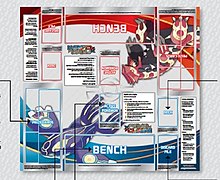Collection: Pokemon
The Pokémon Trading Card Game was developed in Japan, based on the 1996 Pokémon Red, Blue, and Yellow Game Boy video game by Nintendo.[3] It was first published in October 1996 by Media Factory in Japan.[4] In the US, it was first published by Wizards of the Coast, towards the end of 1998 to capitalize on the US popularity of Pokémon.[3] Over the next five years, Wizards of the Coast published more than a dozen expansion sets for the game, allowing the company to sell millions of cards and earn more revenue from Pokémon than they had from Magic: The Gathering in its first 10 years.[3] Hasbro bought Wizards of the Coast in September 1999 for $325 million dollars based on the strength of the Pokémon license.[3] In 2001, Nintendo created its affiliate Pokémon USA, Inc., so that it could recover the US licensing rights to the game.[3] In June 2003, Nintendo transferred the publishing rights from Wizards of the Coast to The Pokémon Company.[5] Wizards sued Nintendo on October 1, 2003 and accused the company of poaching employees and violating its patent; the lawsuit was settled out of court.[3]
Gameplay

The Pokémon Trading Card Game is a strategy-based card game that is usually played on a designated playmat or digitally on the official game client Pokémon TCG Live where two players (assuming the role of Pokémon Trainer) use their Pokémon to battle one another. Pokémon that have sustained enough damage from attacks–that reaches or exceeds its HP–is referred to as being "Knocked Out", granting the opponent a prize card; however, powerful card mechanics like Pokémon-V and Pokémon ex grant extra prize cards when Knocked Out.[1]
Taking all six prize cards is the most common win condition. Other ways to win are by "Knocking Out" or by removing all opponent's Pokémon in play–the Active and those on the Bench (i.e. the row behind the Active that can house up to five additional Pokémon to support and substitute Active Pokémon if it retreats or is "Knocked Out"), or by Decked Out–if at the opponent's next turn they have no cards left in deck to draw into.[1]
Players begin by having one player select heads or tails, and the other flips a coin; the winner of the coin flip will decide who goes first or second. (Dice may be used in place of coins, with even numbers representing heads and odd numbers representing tails; dice are also primarily used in official tournaments organized by The Pokémon Company). The player going first cannot attack or play a Supporter card (powerful Trainer effects card) on their first turn. Players shuffle their decks and draw seven cards, and then each puts one Basic Pokémon in play as their Active Pokémon. This Pokémon is the one that is actively attacking and receiving damage. If a player does not have any Basic Pokémon, they must call mulligan, shuffle, and then draw another hand until they draw a Basic Pokémon; the opponent may draw one additional card per mulligan. Once both players have at least one Basic Pokémon, they can play up to five more Basic Pokémon onto their Bench, and then take the top six cards of their deck and place them to the side as Prize cards.[6][1]
Play alternates between players who may take several actions during their turn, including playing additional Basic Pokémon, evolving their Pokémon, attaching an Energy card, playing Trainer cards, and using Pokémon abilities and attacks. After Trainer cards are played, cards are discarded by effects from Trainer cards or Abilities, and after Pokémon were "Knocked Out", they are put into the discard pile.[1] A player may also retreat their Active Pokémon, switching the Active Pokémon with one on the Bench by paying the Active Pokémon's retreat cost of a certain number of Energies. At the cost of ending the turn, players may use one of their Active Pokémon's attacks once the prerequisite number and types of Energy attached to that Pokémon is fulfilled. Effects from that attack are then activated and damage may be dealt on the defending Pokémon, which may modify based on the defender Pokémon's type weakness or a resistance policies, and/or by any other effects on the defending Pokémon. Players alternate attacking until a player wins either through one of the above win conditions or by concession.[7][1]